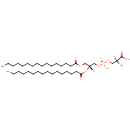
PS(16:0/16:0) (PAMDB000157)
| Record Information | |||||||||||||||||||||||||||||||||||||||||||||||||||||||||||||
|---|---|---|---|---|---|---|---|---|---|---|---|---|---|---|---|---|---|---|---|---|---|---|---|---|---|---|---|---|---|---|---|---|---|---|---|---|---|---|---|---|---|---|---|---|---|---|---|---|---|---|---|---|---|---|---|---|---|---|---|---|---|
| Version | 1.0 | ||||||||||||||||||||||||||||||||||||||||||||||||||||||||||||
| Update Date | 1/22/2018 11:54:54 AM | ||||||||||||||||||||||||||||||||||||||||||||||||||||||||||||
| Metabolite ID | PAMDB000157 | ||||||||||||||||||||||||||||||||||||||||||||||||||||||||||||
| Identification | |||||||||||||||||||||||||||||||||||||||||||||||||||||||||||||
| Name: | PS(16:0/16:0) | ||||||||||||||||||||||||||||||||||||||||||||||||||||||||||||
| Description: | PS(16:0/16:0) is a phosphatidylserine. It is a glycerophospholipid in which a phosphorylserine moiety occupies a glycerol substitution site. As is the case with diacylglycerols, phosphatidylserines can have many different combinations of fatty acids of varying lengths and saturation attached to the C-1 and C-2 positions. PS(16:0/16:0), in particular, consists of two hexadecanoyl chains at positions C-1 and C-2. Phosphatidylserine or 1,2-diacyl-sn-glycero-3-phospho-L-serine is distributed widely among animals, plants and microorganisms. Phosphatidylserine is an acidic (anionic) phospholipid with three ionizable groups, i.e. the phosphate moiety, the amino group and the carboxyl function. As with other acidic lipids, it exists in nature in salt form, but it has a high propensity to chelate to calcium via the charged oxygen atoms of both the carboxyl and phosphate moieties, modifying the conformation of the polar head group. This interaction may be of considerable relevance to the biological function of phosphatidylserine. While most phospholipids have a saturated fatty acid on C-1 and an unsaturated fatty acid on C-2 of the glycerol backbone, the fatty acid distribution at the C-1 and C-2 positions of glycerol within phospholipids is continually in flux, owing to phospholipid degradation and the continuous phospholipid remodeling that occurs while these molecules are in membranes. Phosphatidylserines typically carry a net charge of -1 at physiological pH. They mostly have palmitic or stearic acid on carbon 1 and a long chain unsaturated fatty acid (e.g. 18:2, 20:4 and 22:6) on carbon 2. PS biosynthesis involves an exchange reaction of serine for ethanolamine in PE. | ||||||||||||||||||||||||||||||||||||||||||||||||||||||||||||
| Structure | |||||||||||||||||||||||||||||||||||||||||||||||||||||||||||||
| Synonyms: |
| ||||||||||||||||||||||||||||||||||||||||||||||||||||||||||||
| Chemical Formula: | C38H74NO10P | ||||||||||||||||||||||||||||||||||||||||||||||||||||||||||||
| Average Molecular Weight: | 735.9686 | ||||||||||||||||||||||||||||||||||||||||||||||||||||||||||||
| Monoisotopic Molecular Weight: | 735.505034105 | ||||||||||||||||||||||||||||||||||||||||||||||||||||||||||||
| InChI Key: | KLFKZIQAIPDJCW-GPOMZPHUSA-N | ||||||||||||||||||||||||||||||||||||||||||||||||||||||||||||
| InChI: | InChI=1S/C38H74NO10P/c1-3-5-7-9-11-13-15-17-19-21-23-25-27-29-36(40)46-31-34(32-47-50(44,45)48-33-35(39)38(42)43)49-37(41)30-28-26-24-22-20-18-16-14-12-10-8-6-4-2/h34-35H,3-33,39H2,1-2H3,(H,42,43)(H,44,45)/t34-,35+/m1/s1 | ||||||||||||||||||||||||||||||||||||||||||||||||||||||||||||
| CAS number: | 3036-82-6 | ||||||||||||||||||||||||||||||||||||||||||||||||||||||||||||
| IUPAC Name: | (2S)-2-amino-3-({[(2R)-2,3-bis(hexadecanoyloxy)propoxy](hydroxy)phosphoryl}oxy)propanoic acid | ||||||||||||||||||||||||||||||||||||||||||||||||||||||||||||
| Traditional IUPAC Name: | dipalmitoyl phosphatidylserine | ||||||||||||||||||||||||||||||||||||||||||||||||||||||||||||
| SMILES: | CCCCCCCCCCCCCCCC(=O)OC[C@H](COP(O)(=O)OC[C@H](N)C(O)=O)OC(=O)CCCCCCCCCCCCCCC | ||||||||||||||||||||||||||||||||||||||||||||||||||||||||||||
| Chemical Taxonomy | |||||||||||||||||||||||||||||||||||||||||||||||||||||||||||||
| Taxonomy Description | This compound belongs to the class of organic compounds known as phosphatidylserines. These are glycerophosphoserines in which two fatty acids are bonded to the glycerol moiety through ester linkages. | ||||||||||||||||||||||||||||||||||||||||||||||||||||||||||||
| Kingdom | Organic compounds | ||||||||||||||||||||||||||||||||||||||||||||||||||||||||||||
| Super Class | Lipids and lipid-like molecules | ||||||||||||||||||||||||||||||||||||||||||||||||||||||||||||
| Class | Glycerophospholipids | ||||||||||||||||||||||||||||||||||||||||||||||||||||||||||||
| Sub Class | Glycerophosphoserines | ||||||||||||||||||||||||||||||||||||||||||||||||||||||||||||
| Direct Parent | Phosphatidylserines | ||||||||||||||||||||||||||||||||||||||||||||||||||||||||||||
| Alternative Parents | |||||||||||||||||||||||||||||||||||||||||||||||||||||||||||||
| Substituents |
| ||||||||||||||||||||||||||||||||||||||||||||||||||||||||||||
| Molecular Framework | Aliphatic acyclic compounds | ||||||||||||||||||||||||||||||||||||||||||||||||||||||||||||
| External Descriptors |
| ||||||||||||||||||||||||||||||||||||||||||||||||||||||||||||
| Physical Properties | |||||||||||||||||||||||||||||||||||||||||||||||||||||||||||||
| State: | Solid | ||||||||||||||||||||||||||||||||||||||||||||||||||||||||||||
| Charge: | -1 | ||||||||||||||||||||||||||||||||||||||||||||||||||||||||||||
| Melting point: | Not Available | ||||||||||||||||||||||||||||||||||||||||||||||||||||||||||||
| Experimental Properties: |
| ||||||||||||||||||||||||||||||||||||||||||||||||||||||||||||
| Predicted Properties |
| ||||||||||||||||||||||||||||||||||||||||||||||||||||||||||||
| Biological Properties | |||||||||||||||||||||||||||||||||||||||||||||||||||||||||||||
| Cellular Locations: | Membrane | ||||||||||||||||||||||||||||||||||||||||||||||||||||||||||||
| Reactions: | CDP-1,2-didodecanoylglycerol + L-Serine > Cytidine monophosphate + Hydrogen ion + PS(16:0/16:0) CDP-1,2-dihexadec-9-enoylglycerol + L-Serine > Cytidine monophosphate + Hydrogen ion + PS(16:0/16:0) CDP-1,2-dihexadecanoylglycerol + L-Serine > Cytidine monophosphate + Hydrogen ion + PS(16:0/16:0) CDP-1,2-dioctadec-11-enoylglycerol + L-Serine > Cytidine monophosphate + Hydrogen ion + PS(16:0/16:0) CDP-1,2-Dioctadecanoylglycerol + L-Serine > Cytidine monophosphate + Hydrogen ion + PS(16:0/16:0) CDP-1,2-ditetradec-7-enoylglycerol + L-Serine > Cytidine monophosphate + Hydrogen ion + PS(16:0/16:0) CDP-1,2-ditetradecanoylglycerol + L-Serine > Cytidine monophosphate + Hydrogen ion + PS(16:0/16:0) Hydrogen ion + PS(16:0/16:0) <> Carbon dioxide + PE(14:0/14:0) CDP-diacylglycerol + L-Serine <> Cytidine monophosphate + PS(16:0/16:0) PS(16:0/16:0) <> PE(14:0/14:0) + Carbon dioxide PS(16:0/16:0) + Water <> 2-Acyl-sn-glycero-3-phosphoserine + Fatty acid CDP-DG(16:0/16:0) + L-Serine + CDP-DG(16:0/16:0) + L-Serine > Hydrogen ion + Cytidine monophosphate + PS(16:0/16:0) + Cytidine monophosphate PS(16:0/16:0) + Hydrogen ion > PE(16:0/16:0) + Carbon dioxide PS(16:0/16:0) + Hydrogen ion > PE(16:0/15:0) + Carbon dioxide PS(16:0/16:0) + Hydrogen ion > PE(15:0/16:0) + Carbon dioxide | ||||||||||||||||||||||||||||||||||||||||||||||||||||||||||||
| Pathways: | |||||||||||||||||||||||||||||||||||||||||||||||||||||||||||||
| Spectra | |||||||||||||||||||||||||||||||||||||||||||||||||||||||||||||
| Spectra: |
| ||||||||||||||||||||||||||||||||||||||||||||||||||||||||||||
| References | |||||||||||||||||||||||||||||||||||||||||||||||||||||||||||||
| References: |
| ||||||||||||||||||||||||||||||||||||||||||||||||||||||||||||
| Synthesis Reference: | Hermetter, A.; Paltauf, F.; Hauser, H. Synthesis of diacyl and alkylacyl glycerophosphoserines. Chemistry and Physics of Lipids (1982), 30(1), 35-45. | ||||||||||||||||||||||||||||||||||||||||||||||||||||||||||||
| Material Safety Data Sheet (MSDS) | Not Available | ||||||||||||||||||||||||||||||||||||||||||||||||||||||||||||
| Links | |||||||||||||||||||||||||||||||||||||||||||||||||||||||||||||
| External Links: |
| ||||||||||||||||||||||||||||||||||||||||||||||||||||||||||||
Enzymes
- General function:
- Involved in phosphatidylserine decarboxylase activity
- Specific function:
- Phosphatidyl-L-serine = phosphatidylethanolamine + CO(2)
- Gene Name:
- psd
- Locus Tag:
- PA4957
- Molecular weight:
- 32 kDa
Reactions
| Phosphatidyl-L-serine = phosphatidylethanolamine + CO(2). |
- General function:
- Involved in phosphotransferase activity, for other substituted phosphate groups
- Specific function:
- CDP-diacylglycerol + L-serine = CMP + (3-sn- phosphatidyl)-L-serine
- Gene Name:
- pssA
- Locus Tag:
- PA4693
- Molecular weight:
- 29.3 kDa
Reactions
| CDP-diacylglycerol + L-serine = CMP + (3-sn-phosphatidyl)-L-serine. |
Transporters
- General function:
- Secondary metabolites biosynthesis, transport and catabolism
- Specific function:
- Part of the ABC transporter complex mlaFEDB that actively prevents phospholipid accumulation at the cell surface. Probably maintains lipid asymmetry in the outer membrane by retrograde trafficking of phospholipids from the outer membrane to the inner membrane
- Gene Name:
- mlaE
- Locus Tag:
- PA4455
- Molecular weight:
- 28.4 kDa

